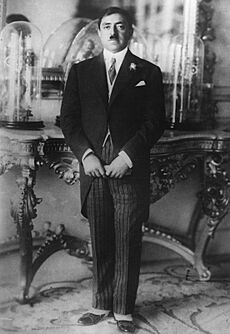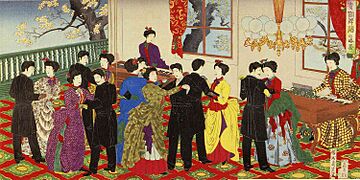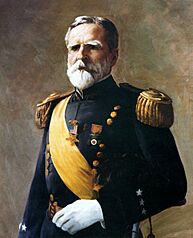Westernization facts for kids
Westernization is a process where societies around the world adopt ideas, ways of life, and technologies that come from Western culture. Think of it like different cultures sharing and borrowing from each other. This can include things like how people dress, the music they listen to, the types of food they eat, or even how their governments work.
This process has been happening for hundreds of years and has become a big influence globally. Some people even think Westernization is the same as modernization, which means becoming more advanced and up-to-date. Westernization often works both ways: Western ideas spread to other societies, and those societies also influence Western cultures in return.
The idea of Westernization started a long time ago with Ancient Greece. Later, the Roman Empire was greatly influenced by Greece. The Romans then created their own culture based on Greek ideas, which became a new "Western" identity.
Westernization is also similar to acculturation. This is when cultures change after they come into contact with each other. When a non-Western society connects with Western culture, it might start to adopt Western ways of thinking, living, and even physical appearances.
The way Westernization happens is different in every society. Some cultures might adopt a lot of Western customs, while others might only take a few. It depends on how much a native culture is affected by new influences, whether it resists, adapts, or changes.
| Top - 0-9 A B C D E F G H I J K L M N O P Q R S T U V W X Y Z |
What is the Western World?
The "West" originally meant the Western world. Over time, this definition changed. For example, the East-West Schism split the Christian church into Catholic and Eastern Orthodox branches. Later, scholars from Islamic and Byzantine cultures helped restart learning in Europe during the Renaissance by sharing old Greek and Roman writings.
During the Cold War, the definition of the West changed again, excluding countries like those in the former Eastern Bloc. Today, "the West" usually refers to societies that have strong cultural, language, and philosophical ties to Western European culture. This includes countries whose main culture comes from Western Europe. Even though they share a history, Western countries are not all the same; they have many cultural, language, religious, political, and economic differences.
Countries Influenced by Western Culture
Many countries and regions have been greatly influenced by Westernization:
- Armenia: Located in West Asia, Armenia's culture has been increasingly influenced by the West. It was the first country to adopt Christianity as its official religion in 301 AD. Today, Armenia has good relationships with Western countries like the United States and the EU. It is part of many European organizations for sports, education, and culture, like UEFA and the Eurovision Song Contest.
- Azerbaijan: This country, located between Western Asia and Eastern Europe, adopted Western traditions mainly due to Russian influence. It had the first opera and secular democracy in the Muslim world before Soviet rule. Azerbaijan is part of European organizations like the Council of Europe and UEFA.
- Cape Verde: An island country in West Africa, Cape Verde has strong influences from European culture, especially Portuguese. It has close ties with Spain and Portugal and has tried to connect with Western groups like the EU.
- Hong Kong, Macau, and Singapore: These places in East Asia and Southeast Asia are partly Westernized because of strong European heritage, especially from Britain and Portugal.
- Israel: Although in Western Asia, Israel has many Western cultural influences brought by Jewish settlers from countries like Canada, France, Germany, the UK, and the US. It is a member of the OECD and often participates in European sports and cultural events like UEFA and Eurovision.
- Japan, South Korea, and Taiwan: These East Asian countries have become Westernized by adopting democratic governments and free market economies. They have also made big contributions to Western science and technology.
- Americas: Most countries in the Americas are considered Western because many of their people are descended from Europeans. Their societies work in a very Western way. Most use English, French, Spanish, or Portuguese as their official language. Many Europeans also moved to South American countries like Argentina, Brazil, Chile, and Uruguay.
- Lebanon: In Western Asia, Lebanon is the most Westernized Arab country. It was influenced by ancient Greek and Roman empires. It has the highest number of Christians in the Arab world, and France has promoted French culture and European-style education there. French is still widely spoken.
- Philippines: In Southeast Asia, the Philippines is considered Westernized due to strong influences from Spanish and American cultures. Nearly 90% of Filipinos are Christian.
- Thailand: This Southeast Asian country avoided direct Western colonization. It Westernized itself by centralizing its government and becoming a constitutional monarchy. Thailand became a key ally of the United States in the 1950s and still has strong ties to Western countries.
- Turkey: Although mostly in Western Asia, Turkey is one of the most Westernized Turkic countries. It has a customs union with the European Union and is a member of Western organizations like the OECD, the Council of Europe, and NATO. It also participates in European sports events like UEFA and the Eurovision Song Contest.
- Vietnam: In Southeast Asia, Vietnam was influenced by French rule. It adopted the Latin alphabet instead of its traditional writing systems. Many French-style buildings were built, and Christianity has a big influence. Vietnam is also a member of the Organization of la Francophonie.
Different Views on Westernization
Kishore Mahbubani's Ideas
Kishore Mahbubani wrote a book called The Great Convergence. He believes that a new global culture is forming, where many non-Western countries admire Western ways of life. He thinks that leaders worldwide need to accept that we live in one connected world. He suggests that countries should balance their own interests with global interests and share power to create a peaceful world.
However, Mahbubani also argues in another book, The New Asian Hemisphere, that Western influence is "unraveling" as Eastern powers like China grow. He says that people outside the West no longer believe Western civilization is always better. He gives reasons for this decline:
- Western countries seem to focus more on their own problems than global issues.
- The West is sometimes biased against non-Western countries, like calling China "un-free" for not being a democracy.
- The West uses different rules for different countries.
- As Eastern populations gain more power, they are moving away from Western influences.
Samuel P. Huntington's Ideas
Samuel P. Huntington had a different view. He believed that after the Cold War, world politics would be shaped by cultural differences, not just political ideas. He saw the world divided into several civilizations based on religion, like Western Christian, Islamic, Hindu, and Slavic-Orthodox.
Huntington thought that non-Western civilizations were no longer just receiving Western culture but were becoming important players in shaping world history. He suggested three ways non-Western countries could react to Western influence: 1. Isolation: Try to stay separate to protect their own values, but this is very difficult. 2. Joining the West: Accept Western values and ways of life. 3. Balancing Power: Modernize and build their own economic and military strength, even working with other non-Western countries, while still keeping their own values.
Edward Said's Ideas
In his book Orientalism, Edward Said looked at Westernization through the lens of colonialism. He argued that Western powers, like Britain, often described colonized people in a way that made them seem "different" or "inferior." This helped justify controlling them.
Said pointed out that when Westerners claimed to "understand" another civilization completely, it allowed them to dominate it. He believed that by labeling other cultures as "irrational" or "childlike," the West also defined itself as "rational" and "mature." So, "the West" and "the Orient" (the East) were ideas created to support certain power relationships, like colonization.
How Westernization Happens
Colonization and Europeanization (1400s–1970s)
From the 1400s, Europeanization and colonialism slowly spread across much of the world. European powers controlled many regions for about five centuries.
After World War II, many Western leaders wanted to promote freedom and equality worldwide. This led to a period of decolonization, where most colonies gained independence by the late 1960s. These new countries often adopted some Western political ideas, like having a constitution, but sometimes reacted against Western culture.
In Asia

Countries in Asia have reacted to Westernization in different ways. Some, like Korea and China, tried to stay isolated. However, they eventually blended parts of Western culture into their own. For example, the Western fast-food chain McDonald's now has over 1,300 locations in China. In Taiwan, bridal photography has been influenced by the Western idea of "love." Couples now often show more affection and take photos in Western-style settings.
Korea
Korea first encountered Westernization in the 17th century during the Joseon Dynasty. Korean ambassadors visiting China learned about Western technology from missionaries there. In the 19th century, Korea started sending ambassadors to other countries. Korea adopted Western technology but kept its own "Eastern ways and Western frames," meaning they used Western tools with Eastern principles.
Japan

In Japan, the Netherlands played a key role in sharing Western knowledge from the 17th to mid-19th centuries. After US Navy Commodore Matthew Perry's visit in 1853, Japan actively embraced Western culture. They even hired Westerners to teach their customs during the Meiji era. Many Japanese politicians supported Westernization, calling it an "unavoidable" but "fruitful" change. However, Japan has kept its strong social hierarchy and less focus on individualization.
Iran
In Iran, Westernization attempts began in the 1930s under Shah Rezā Khan and continued with his son. This process upset many conservative Shia Muslim people, which partly led to the 1979 Iranian Revolution.
Turkey
In Turkey, the process of becoming more like the West is called the Tanzimat period. The Ottoman Empire started to adopt modern science, practices, and culture from the West. They improved their army and established new schools and permanent ambassadors. Because of these changes, Turkey is one of the most Westernized Muslim-majority nations.
Globalization (1970s–present)
Westernization is often seen as part of globalization, which is the process of the world becoming more connected. This idea suggests that Western thinking led to globalization, and globalization then spreads Western culture, creating a cycle of Westernization. Many Western technologies and customs, like music, clothing, and cars, have spread globally and are now copied or created in non-Western countries.
In some countries, Westernization has been reversed after wars or changes in government. For example, Russia after the Bolshevik Revolution in 1917, Continental China by 1949, Cuba after the Revolution in 1959, and Iran after the 1979 revolution.
After the break-up of the USSR in 1991, many of its former states and allies became more Westernized. This included privatization of industries that were once controlled by the state.
The debate continues about whether globalization is the same as Westernization. Globalization involves many aspects like economics, politics, food, and culture. Some believe that globalization makes the world more like Western powers. Examples like democracy, fast food, and American pop culture are often seen as signs of the world becoming Westernized.
Social media also plays a role in Westernization. Some Eastern societies, like Iran and China, have banned Western social media platforms like Facebook and Twitter. This shows a political desire to prevent their populations from becoming too Westernized in their communication styles.
Effects of Westernization
Because Europeans colonized the Americas and Oceania, the cultures, ethnic groups, and languages in these regions changed a lot. This is most clear in countries like Australia, Canada, New Zealand, and the United States. In these places, the original native populations were largely replaced by settlers from Europe, often due to diseases and conflicts. This led to native people losing their languages, social structures, and cultures. Even in countries where many native people still live or have mixed with European settlers (like Mexico or Peru), they often face marginalization.
Language Changes
Due to colonization and immigration, the main languages spoken in the Americas, Oceania, and parts of South Africa are now usually European languages or new languages based on them (creoles):
- English is spoken in Australia, New Zealand, the United States, and Canada (except French-speaking Quebec). It's also spoken in many parts of Africa, the Caribbean, and Asia.
- French is spoken in Quebec, New Brunswick, and parts of Ontario in Canada, as well as in many African countries, the Caribbean, and some Pacific islands.
- Spanish is spoken across most of the Americas, Equatorial Guinea, and the Philippines.
- Portuguese is spoken in Brazil, many African countries, East Timor, and Macau.
- Dutch is spoken in Suriname, Aruba, and the Netherlands Antilles.
- Afrikaans (a language based on Dutch) is spoken in parts of South Africa and Namibia.
- German is spoken in some areas, like Pennsylvania in the US.
Many native languages are now in danger of disappearing. However, some countries have worked to preserve indigenous languages. For example, in New Zealand, the Māori language is one of three official languages. In Ireland, Irish is the first official language.
Sports and Westernization
Sports have become important partly because of Westernization. Modern sports, especially those from Anglo-American cultures, spread around the world. These sports were seen as good for physical activity, learning, and building character. While some cultures adopted them willingly, others saw it as a form of cultural influence.
See also
- Acculturation
- Anti-globalisation
- Colonial mentality
- Colonialism
- Cultural assimilation
- Cultural diversity
- Cultural imperialism
- Democratisation
- Globalisation
- Modernization
- Multiculturalism
- Pop culture



